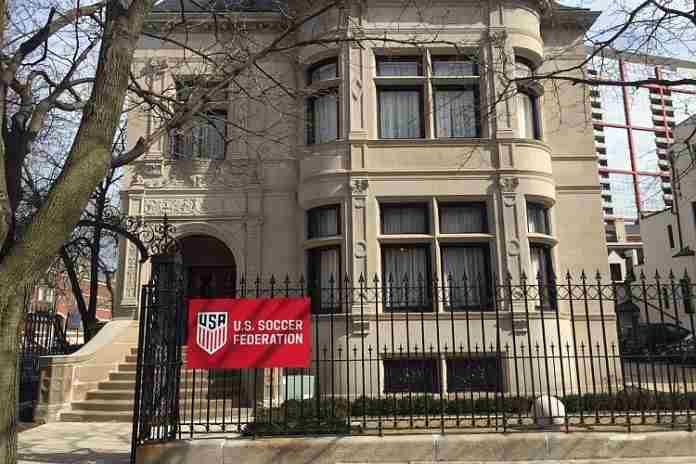The 28 members of the U.S. Women’s National Team in soccer filed a complaint for damages in U.S. Federal Court against the U.S. Soccer Federation on 8 March, alleging violations of the Equal Pay Act and the Civil Rights Act.
One week later, the U.S. Soccer Federation President, Carlos Cordeiro, posted an open letter on Twitter which addressed the suit in some detail, including:
“U.S. Soccer believes that all female athletes deserve fair and equitable pay, and we strive to meet this core value at all times.
“Specifically, in April of 2017, we agreed to a fair and equitable collective bargaining agreement with the Women’s National Team, which included a contract structure that the players specifically requested to provide them with a guaranteed salary and benefits. At no point since that time have players raised concerns about the CBA itself, and we continue to work with them in good faith. …
“We were therefore surprised by the complaint filed last week by the U.S. Women’s National Team.”
Cordeiro was predictably criticized for being “surprised” and worse, but that’s irrelevant from where he sits now. It’s worth noting that he was elected in 2018, after the agreement with the women’s team was completed. It’s also important to remember that he didn’t get to be a partner at the massive Goldman Sachs investment firm by being asleep.
The amazing thing is that Cordeiro responded to the suit at all. Lawyers will tell you – for good reason – that silence is golden once a complaint is filed, because anything which is said can be used, potentially to your detriment.
But Cordeiro went much, much further:
“As we continue to review the lawsuit, we thought it was imperative to reach out to team leaders to better understand their thoughts and concerns. While we believe that the current agreement is fair and equitable, we are committed to working with our USWNT players and understanding specifically where they believe improvement is needed.
“To that end, on Wednesday I spoke to some of the veteran players to better understand their thoughts and concerns. Our initial conversation was open, cordial and professional, and we will continue to work to resolve the matter.
“We are looking forward to additional meetings with the players in the near future so we may learn more about their objectives while they, in turn, can hear from us. Our mutual goal is a dialogue that will serve the best interests of the USWNT and U.S. Soccer, so that our collective focus is where it should be – winning the 2019 FIFA Women’s World Cup at a time when our team and soccer in the U.S. has so much to gain and celebrate.”
From a strictly legal perspective, Cordeiro gave away nothing; he wants to talk. But there is a much more interesting game going on, on and off the field.
There will be a response to the complaint from U.S. Soccer, which will have a different set of facts and numbers from those cited by the team’s lawyers. But Cordeiro is perhaps looking for something to benefit both sides.
Let’s face it: the no. 1-ranked U.S. women have looked anything but that in their first five games of 2019. After being pummeled by France in Le Havre, 3-1, the American squad beat Spain, 1-0, and then played two 2-2 draws in the SheBelieves Cup against Japan and England and struggled to beat Brazil, 1-0.
That’s a 2-1-2 record, with seven goals scored and seven given up. The U.S. has struggled to control the ball in the midfield and has found it hard to create scoring chances. Julie Ertz, now an attacking midfielder who was a crucial weapon on corner kicks and free kicks last year, has yet to score this season. And, the defense has been shaky, giving up two goals in consecutive games against Japan and England. The U.S. women gave up two goals or more in a game twice in all of 2015-16-17-18, but now three times already in 2019. The last time it did that was in 2014, when it gave up two goals or more on three occasions the entire year.
Moreover, the core of the American team is aging. Its most impactful player, striker Megan Rapinoe, is 33. Striker Alex Morgan, the top scorer, is 29. Prime defenders Becky Sauerbrunn and Kelley O’Hara are 33 and 30, respectively. The top two keepers, Alyssa Naeher and Ashlyn Harris, are 30 and 33.
Sure, they’re fine for 2019 and for the 2020 Olympic Games in Tokyo. But add four years for the 2023 Women’s World Cup and there are questions about whether these stars will still be in top form. Super-striker Abby Wambach retired at 35 after the 2015 season and Carli Lloyd, the star of the 2015 Women’s World Cup champions, is now a substitute at age 36.
Now look at the position of U.S. Soccer. If the Women’s National Team is going to produce the revenue that it has in the past, and that it can going forward, it needs to go deep into the World Cup in June and not make the early exit the 2016 Olympic Team did, losing to Sweden on penalty kicks, 4-3, after a 1-1 draw in the quarterfinals.
You can almost – almost – read Cordeiro’s mind. What would a settlement, on terms that U.S. Soccer can afford, do for the psyche of the team and especially for its leadership? It’s not by accident that Lloyd, Rapinoe, Morgan and Sauerbrunn are the named plaintiffs for the requested class action certification in the complaint. Could an agreement on a new Women’s National Team contract energize those four, and through them the rest of the team?
As the suit was just filed, and taking Cordeiro’s letter at face value – that he was surprised by the filing – no one is crunching numbers yet at 1801 S. Prairie Avenue in Chicago. But they likely will be soon enough.
A lot of this depends on the players and whether they want a new agreement, or want to push their complaint forward toward a trial, which will not come for months and perhaps not for more than a year, or even after the Tokyo Games.
But for someone from the financial community like Cordeiro, who understands the value of assets and the diminishing value of assets over time, maximum value might be available right now for both sides, if the U.S. women can regain their high-possession, high-scoring play seen in 2018.
All of this will make the next two games for the U.S. women, against no. 6 Australia (which has really given the U.S. a tough time) and no. 21 Belgium on 4 April and 7 April, just that much more important.
If the U.S. looks great and pounds both opponents – especially Australia – the power of the players in a negotiation (if there is one) will be enhanced. More problems on the field, and it will behoove both sides to come together on an agreement, and quickly.
There is a lot riding on the U.S. women and their performance in the World Cup in France in June, for both the players and for U.S. Soccer. The players know it, and so does Cordeiro, but for different reasons, and that might be why they could create a agreement that will motivate both sides. They need to.
Rich Perelman
Editor
















